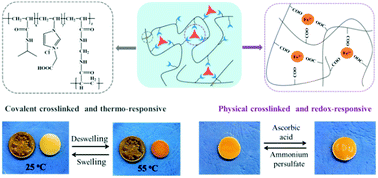Facile fabrication of thermo/redox responsive hydrogels based on a dual crosslinked matrix for a smart on–off switch†
Abstract
Stimuli-responsive or “smart” soft materials have raised considerable attention due to their ability to spontaneously respond to external environmental variations and have a great potential for wide applications. Herein, a thermo/redox responsive hydrogel is facilely constructed based on a dual crosslinked matrix: the primary chemical crosslinked copolymer is composed of thermo-responsive poly(N-isopropylacrylamide) (PNIPAM) and poly(ionic liquid), and the secondary physical crosslinking component is generated by the ionic coordination between iron ions and carboxyl groups in the poly(ionic liquid). The non-covalent ion coordination crosslinking is introduced into a covalently crosslinked network, which further strengthens the soft PNIPAM matrix and enhances the mechanical performances of the hydrogels. The excellent thermosensitivity of PNIPAM and the good conductive property of poly(ionic liquid) provide the hydrogel with an attractive performance as a thermo-responsive switch. Moreover, the trapped iron ions in the network endow the hydrogels with redox-responsiveness, which could be reversibly chemically oxidized and reduced. The mechanical strength of hydrogels could also be tuned by the crosslinked capacity of iron ions within the gel matrix between the strong binding of the oxidized state (Fe3+) and poor coordination of the reduced state (Fe2+). These stimuli-responsive hydrogels have the potential to be used as smart materials for stimuli-responsive devices.



 Please wait while we load your content...
Please wait while we load your content...